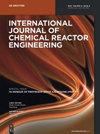Numerical and experimental investigations on enhancement mixing performance of multi-blade stirring system for fluids with different viscosities
IF 1.6
4区 工程技术
Q3 Chemical Engineering
International Journal of Chemical Reactor Engineering
Pub Date : 2023-01-10
DOI:10.1515/ijcre-2022-0151
引用次数: 0
Abstract
Abstract The poor mixing caused by zinc powder deposition in purification process is a serious problem which can’t be avoided in treatment of zinc-containing solid waste. Here, to enhance the purification efficiency of zinc-containing solid waste treatment reactor, two kinds of multi-blade combined stirring systems are compared with single layer four straight-blade and double-layer straight-blade (DFB) stirring systems which are traditionally chosen by industry. This study simulated and explored the flow field characteristics and purification effects of these four kinds of stirred-tank reactor, further proposes the unit ion purification energy (UIPE) as a criterion for purification energy consumption and effect evaluation. The results show that multi-blade combined (MBC) stirring system enhances axial flow by 12.56% in water. Meanwhile it effectively inhibits the growth of isolated mixing region which scope has decreased by 56.25%. In high viscosity Carboxymethylcellulose sodium solution, the fluid axial speed can be increased by up to 1407 times with MBC. MBC can increase the purification rate by 24.79% while the UIPE decreases by 29.45% compared with DFB which is used in industrial purification process. MBC paddle has exhibited a wide range of fluid viscosity applicability and axial velocity improvement effect. The improvement increases collisions between the impurity particles and the zinc powder particles, which increased rate of substitution reactions. The application of MBC solves the purification problem in the process of treating zinc-containing solid waste.多叶片搅拌系统增强不同粘度流体混合性能的数值与实验研究
摘要提纯过程中锌粉沉积引起的混合不良是含锌固体废物处理中不可避免的严重问题。为了提高含锌固体废物处理反应器的净化效率,将两种多叶片组合搅拌系统与工业上传统选用的单层四直叶和双层直叶(DFB)搅拌系统进行了比较。本研究模拟并探讨了这四种搅拌槽反应器的流场特性和净化效果,进一步提出了单位离子净化能(uppe)作为净化能耗和效果评价的标准。结果表明,多叶片组合搅拌系统可使水中轴流提高12.56%。同时有效抑制了孤立混合区的生长,使其范围减小了56.25%。在高粘度羧甲基纤维素钠溶液中,MBC可使流体轴向转速提高1407倍。与工业净化工艺中使用的DFB相比,MBC的净化率提高了24.79%,而upe的净化率降低了29.45%。MBC桨片具有广泛的流体粘度适用性和提高轴向速度的效果。这种改进增加了杂质颗粒与锌粉颗粒之间的碰撞,从而提高了取代反应的速率。MBC的应用解决了含锌固体废物处理过程中的净化问题。
本文章由计算机程序翻译,如有差异,请以英文原文为准。
求助全文
约1分钟内获得全文
求助全文
来源期刊
CiteScore
2.80
自引率
12.50%
发文量
107
审稿时长
3 months
期刊介绍:
The International Journal of Chemical Reactor Engineering covers the broad fields of theoretical and applied reactor engineering. The IJCRE covers topics drawn from the substantial areas of overlap between catalysis, reaction and reactor engineering. The journal is presently edited by Hugo de Lasa and Charles Xu, counting with an impressive list of Editorial Board leading specialists in chemical reactor engineering. Authors include notable international professors and R&D industry leaders.

 求助内容:
求助内容: 应助结果提醒方式:
应助结果提醒方式:


